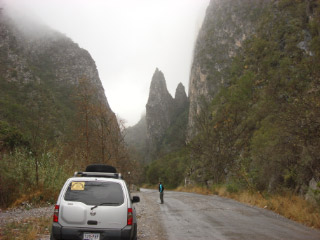 Day 3 – January 16 – Cola de Caballo and Highrise, Nuevo León
Day 3 – January 16 – Cola de Caballo and Highrise, Nuevo LeónChapter 2. Sierra Madre Oriental
(Bert) Shari conducts the travel meeting under the street lamp where our RV’s
are all parked in a long line. Just as dawn is graying the black sky we’ve
learned the idiosyncrasies of today’s route across the border, through crowded
McAllen streets, into the countryside of the Monterrey cuota road and the
uncertainty of what we might find in Caldereyta. CB count off completed, we head
to the border where the military guards remove orange cones when they see us
coming, so that we can bypass the low ceiling overhang where they check
vehicles. Nonetheless they do attempt to check one of the pop-up trailers, but
when I halt the whole caravan across their work area, they decide the
complication of raising the pop-up is not worth their time. Through the city we
snake and pause momentarily just before an under bridge where our road log says
follow the signs to Monterrey,
(Shari) Well, I got it over and done with early this time around. It will not happen again during the trip. We cross the border at Pharr, driving the road that parallels the canal between the U.S. and Mexico and turn deeper into Mexico looking for a sign to Monterrey. As we pass an unmarked road that looks like it leads to an expressway above us, I tell Bert that I bet that was the road we want to take. Sure enough a block farther, Bert recognizes we are heading to Victoria and not Monterey. Now we have to make a U-turn in Mexico during morning rush hour. Of course we have a train of 11 others following us they have to do the same thing. We recover and soon hear that Tailgunners Larry and Marlene have also made the turn, which means everyone else ahead of them has also.
(Bert) Shari and I disagree about going straight or turning right. I recall going straight last year (toward Tampico) and I proceed. Shari is correct, though, and we should have turned right, although the intersection is unsigned. We make a quick recovery and I lead the caravan in a broad U-turn and soon we are on the main thoroughfare that will take us out of the city.
The flat countryside of the Tamaulipas plain is at first green with fresh grass, but farther it becomes winter brown. We use the CB’s to point out a Gray Hawk, White-tailed Hawk and Harris’s Hawks, but the transmissions are unheard, garbled or misinterpreted. Although I can hear almost all transmissions, not everyone can hear mine, so the Gray Hawk is transformed into a Prairie Hawk by the time the message is relayed three times. We fidget with our CB dials, adjusting the squelch until at least most of us are communicating. Later, on subsequent days, we will split up into smaller groups, but today we stretch out along the toll road for two miles. We want the group together when we tackle Caldereyta. Although Shari and I have visited the small city three times, construction has always made the route questionable and the newest 2009 Guia Roji indicates a new road bypassing the city.
(Shari) We get on the toll road and make great progress towards Monterey. At lunch I ask about the road towards Allende since I notice on the map that it looks new and different than five years ago. I literally ask five people and do not find anyone who speaks English but all are interested and gather around me as I converse with the convenience store clerk, in my Spanish of a two-year old. Everyone has an opinion on where I turn off. Do I pay a toll before or after the turn? Does the road have a sign indicating where it turns? Then what do I do? All I am sure of after that exchange is that I must take the exit to Caldereyta. As I leave the store, I notice a well-dressed older man and woman drive toward me. They stop their car and I ask if they speak English. Actually he does speak very well and gives me directions. I am a little more optimistic that we will find our way until I realize this is the same road we always take. If that is the case, we will need help making a returno. Approaching Caldereyta, a guardian angel sends the police and we stop the whole caravan on the side of the road as I talk, again like a two-year-old, asking for help to lead us to Allende. Soon we have a police escort with flashing lights and all. At the returno two police cars have stopped traffic in one direction and another has stopped it in the opposite direction, clearing the way for our group to cross traffic. Someone mentions over the CB that the whole town, including the dogs, is watching us. The police car stops when we are on the main road to Allende. We are so grateful that we give him $20. I wonder if he shares it with his coworkers who also helped. About an hour later we arrive at camp. Larry, Marlene and Bert tediously park everyone while I arrange payment and dinner for tomorrow. Boy, are we ready for margaritas. I start my machine and soon the group gathers for Birding 101. Seems the margaritas are a hit, since the container is empty with many wanting more. It has been a good first day.
(Bert) At a rest stop, Shari asks several Mexicans for road information, but gets conflicting answers. When we reach the city’s edge I stop and Shari talks to a traffic policeman parked on the side. She will probably relate the story in her journal, but the short version is we take exactly the same route we have traveled the three previous times, the only difference being the final road out of the city is now nicely paved and wider.
Later, now at the campground bordering a picturesque lake with a backdrop of towering mountains, we gather for margaritas, my presentation of Birding 101 and a bird count off of the 37 bird species we saw in route, plus one coyote. Shari switches subjects and discusses caravan business, briefly interrupted when we see a Chihuahuan Raven overhead. The margaritas are quickly consumed along with the Mexican-style snacks. This group likes margaritas; we may have to make more next time.
 Day 3 – January 16 – Cola de Caballo and Highrise, Nuevo León
Day 3 – January 16 – Cola de Caballo and Highrise, Nuevo León(Bert) Rain pitter-pattered on the roof of R-Pup-Tent – the name we give our
Class C motor home – throughout the night and is still falling when I step
outside shortly before 7. When a few other raincoat-clad birders venture out,
one asks if the birding trip is cancelled and I answer “Never”. Besides, high in
the mountains beyond Cola de Caballo, the weather could be quite different. Rain
continues as we make the ascent on slippery pavement, up and around hairpin
turns, beyond the waterfalls and into the clouded pine forests. After an hour’s
drive, 15 miles, we start to level out and then reach the apple orchards and
stretched out little villages and resorts of the basin. Under darkened overcast
skies, the rain has stopped and birding begins with a pair of Hepatic Tanagers,
one yellow, her partner red. The birds that delight us are the black-headed
yellow oriole called Audubon’s, the omnipresent loudly calling Mexican Jays and
a few Black-headed Grosbeaks and the bug-eyed Yellow-eyed Juncos. Our road of
broken pavement and rock winds through the mountain pass, sometimes surrounded
by steep cliffs, sometimes following a dry river bed with occasional puddles and
trickling water where Black Phoebes reside. Two species alternately elude us and
then seem plentiful: life birds for some, the attractive Rufous-capped Warblers
and Painted Redstarts. One redstart puts on a close-up show
while Paul and I
both have our Canon’s and 100-400 mm lens pointed at the action.
We continue to climb, yet at a more gradual pace, surrounded by spectacular sheer rock mountains, the cliffs of Highrise another thousand feet above us, on the road that ultimately would lead to Saltillo had we the time to travel it all. We break for lunch, oft interrupted by the birds surrounding us. For me, the best bird of the day is an Empidonax flycatcher that gives us pause in its identification, but as we accumulate field marks – notable crest, eye ring elongated at back, yellowish undersides, yellow lower mandible – I recognize the Pine Flycatcher. The main point of my interest is the comparison to descriptions and discussions of the Texas bird now at Choke Canyon and generating dozens of e-mails to Texbirds about whether that bird really is Pine, the first sighting for the U.S. I note our location N25º 21.31’ W100º 20.20’ and elevation 6340 ft. As we descend from the mountains, we again enter clouds and rain and by the time we reach our campsite on lake Presa Rodrigo Gómez, elevation 1585 ft., it is still raining. Shari tells me it rained all day. Not for us.
(Shari) I hear the rain on the roof long before Bert gets up. I have always wanted to accompany the group on today’s excursion, but was usually too busy with logistics. Today I think I would not want to go anyway. As I hear him get up, I roll over and snuggle under the covers to awaken leisurely on my own terms. I take care of updating road logs, writing journals, making payments, cleaning R-Pup-Tent, and browning meat for tomorrow’s soup before walking to Marlene and Larry’s for staff meeting number 2. The day disappears and I still have work to do, but decide to enjoy the Olympic indoor heated pool with Bert later in the afternoon. Walking fast down the cement slope to the pool to lessen our time in the rain and cold, we are disappointed that the pool is covered. As we are about to return back, two people indicated that they will remove the cover and have it off in short order. We hurry into the nice warm water and just relax. I think the Jacuzzi might be warmer so I hurry to it and find it marginally better at 95 degrees. The sauna is not working. At least we can return home clean if not toasty warm. Before I know it, the van is parked in front to take us to the restaurant for dinner. Sitting at three round tables we serve ourselves from the buffet line that has twice as much food as we can eat. The cream of avocado soup is especially delicious. Along with salad, chicken fajitas, fish, rice, beans, and mashed potatoes there is hardly room for the best flan I have ever eaten in Mexico. We return in the van full and tired.
(Shari) One of the “policia” sent by the hotel to help us stop traffic on the road this morning speaks a little English. I inform him that we are departing in three groups of four RV’s each. He seems to understand and takes the lead. On a loud speaker he announces to oncoming traffic to stay to the right as we negotiate the narrow road out to the main highway. He then turns at the first “returno” but we do not follow since we know we are too tall to make it under the bridge. That is the last we see of them. We continue on our own another mile and luckily traffic is not too thick for our groups of four easily to negotiate the 180 degree turn. Pod One - as I call our first group - just finishes the turn when we hear on the CB that Pod Two is ready to depart.
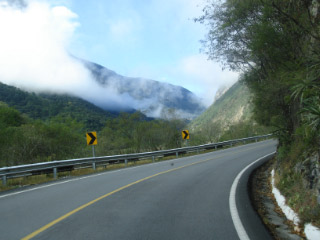
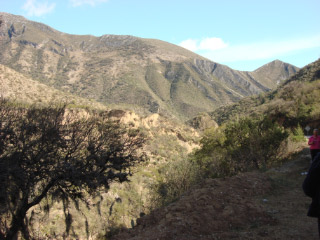
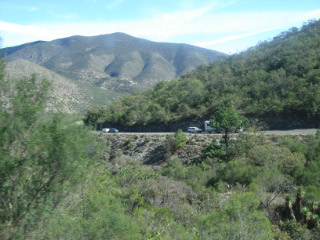
(Bert) Clouds cloak the mountains to the west, down to their feet, as we drive south toward Linares. Uneventfully, I drive cautiously in the rain, gently braking on the curves as I don’t want to slide on the slippery pavement. A couple hours into the morning we turn west through a pass in the mountains. Rain stops; skies clear; sun shines on the tall green mountains. We weave through the Sierra Madre Oriental, marveling at the mountain scenery which changes at each turn. A dry habitat, the deciduous trees are short and become sparser as we gain elevation. We make a brief stop on one of the few pullouts long enough for four vehicles and I hear a Canyon Wren singing. The serpentine highway tops off at 6655 ft., now in pine forest, and we stop at a dilapidated Pemex station for our lunch break. As always, we check out the area for birds, finding Vermilion Flycatcher, Eastern Bluebird, Lesser Goldfinch and Hepatic Tanagers. I also encounter the gas station owner living behind the station in an old Class C RV with an attached 20-ft TV antenna. We talk briefly when I notice his RV has Texas plates and I am also from Texas.
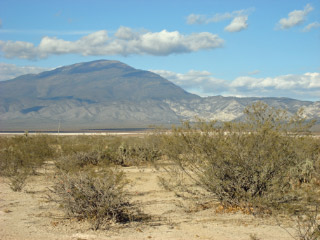 We begin a gradual descent into Mexico’s Northern Plateau, bypassing Cerro El
Potosí – Mexico’s 14th highest at 11,995 ft., now cloud-covered. We stop to park
for the night in an abandoned Pemex station where we have stayed other years.
After our RV’s are all set up and we have detached vehicles for birding, our
departure is interrupted by a Mexican man who speaks no English. He speaks
rapid-fire Spanish so fast that none of us understand him and I go to retrieve
Shari who eventually manages to slow him down to a pace she can understand. I’ll
leave it to Shari to relate the strange and often comical experience of what we
learn.
We begin a gradual descent into Mexico’s Northern Plateau, bypassing Cerro El
Potosí – Mexico’s 14th highest at 11,995 ft., now cloud-covered. We stop to park
for the night in an abandoned Pemex station where we have stayed other years.
After our RV’s are all set up and we have detached vehicles for birding, our
departure is interrupted by a Mexican man who speaks no English. He speaks
rapid-fire Spanish so fast that none of us understand him and I go to retrieve
Shari who eventually manages to slow him down to a pace she can understand. I’ll
leave it to Shari to relate the strange and often comical experience of what we
learn.
Instead, I’ll jump to our birding the desert area surrounding where we have
stopped for the night. Driving a mile north and then behind a dusty village, we
spread out on foot to canvas the desert. I am called hither and yon as birders
ask me to help in identification. The birdlife is a good variety and always
surprising to me in such a forbidding habitat. We find Scaled Quail, Cactus
Wren, Loggerhead Shrike, Curve-billed Thrasher, Pyrrhuloxia, Canyon Towhee, Lark
Bunting and Black-throated Sparrows, among others.
(Shari) This leg of the trip is my favorite as we travel up in a canyon with beautiful views of the mountains most of the day. Traveling in smaller groups allows us to stop to enjoy the scenery and to take pictures. Soon we are at our camping spot for the night, an abandoned truck stop that has looked the same for seven years. We settle ourselves toward one end, get out tables and chairs for a special dinner.
However, all is not well and Bert is asking me to talk to a man who is speaking rapid Spanish. As I talk with the Mexican, I learn that his boss does not want us to park here. I ask him why, since we did it five years ago and seven years ago. He repeats, he just does not want us to park here. I then ask him, where can we park? He indicates down the road someplace. Not an answer I want to hear. I ask him if we can park farther up the lot. He says no. Finally I tell him that I will pay. Oh, now we are getting somewhere. But first he wants 100 pesos to use his cell phone to call his boss in Monterrey. I think that is a lot for a phone call and after Bert gives him the money he tromps off to the restaurant. We hurry to catch up, following our money. Now we find out he needs the pesos to buy a calling card so that he can call his boss. We tromp back and he calls Monterrey to talk with his boss. I ask if his boss is nice and he says no. I ask if his boss speaks English and if I can talk to the boss. He says he doesn’t know. Finally we settle on $60 for the lot of us to stay the night and a $5 tip for him. He will not accept pesos but wants U.S. dollars. I retrieve the money and we are all set to stay the night. Now this may seem easy in the telling but you have to understand that this took over an hour in my two-year-old childlike Spanish. You see, I know a lot of words in Spanish but he had to use the words that I know and there was a lot of “No entiendo este palabra” going on, i.e., “I do not understate that word.” So he would use another word. We did get the job done and that is what counts.
Finally I am free to enjoy the gin and tonic Jane made for me and fix the taco soup (a recipe I got from my friend Ginny). The soup is loved by all and we devour it, going back for seconds and thirds using all the variety of toppings supplied by the group to garnish our bowls. The temperature turns cold really fast after the sun goes down and all are in their rigs by nightfall.